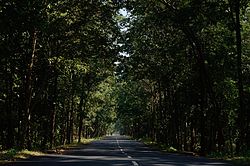Ecosystem services
Ecosystem services are processes by which the natural environment produces resources useful to people, as to economic services. They include:
- Provision of clean water and air
- Flood control
- Pollination of crops
- Mitigation of environmental hazards
- Pest and disease control
- Carbon sequestration
- Aesthetic, cultural and ethical values associated with biodiversity.
To look at the way in which ecosystems provide goods is popular now at Stanford University. The concept of ecosystem services is similar to that of natural capital.
The Millennium Ecosystem Assessment released in 2005 showed that 60% of ecosystem services are used in a way that destroys them.
Ecosystem Services Media
An example of an ecosystem service is pollination, here by a honey bee on avocado crop.
Social forestry in Andhra Pradesh, India, providing fuel, soil protection, shade, and even well-being to travelers.
Upland bog in Wales, forming the official source of the River Severn. Healthy bogs sequester carbon, hold back water thereby reducing flood risk, and supply cleaned water better than degraded habitats do.
Detritivores like this dung beetle help to turn animal wastes into organic material that can be reused by primary producers.
Sustainable urban drainage pond near housing in Scotland. The filtering and cleaning of surface and waste water by natural vegetation is a form of ecosystem service.
References
- Ecosystem Services: A Primer Archived 2010-07-26 at the Wayback Machine, Ecological Society of America (ESA)
- The New Economy of Nature: The Quest to Make Conservation Profitable (ISBN 1-55963-945-8), Gretchen C. Daily and Katherine Ellison.
- Ecosystem Services: Backgrounder Archived 2006-12-09 at the Wayback Machine, The Ecosystem Marketplace






